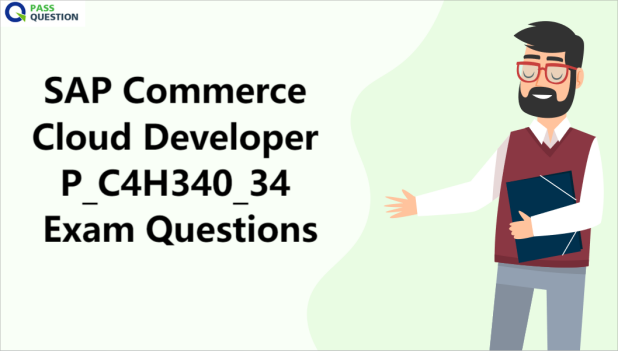SAP Commerce Cloud Developer P_C4H340_34 Exam Questions
The P_C4H340_34 exam is an essential component of the SAP Certified Development Professional certification for SAP Commerce Cloud Developer. PassQuestion offers a comprehensive range of SAP Commerce Cloud Developer P_C4H340_34 Exam Questions to support your preparation. With our latest SAP Commerce Cloud Developer P_C4H340_34 Exam Questions, you will have access to up-to-date and relevant study materials that will equip you with the necessary tools to excel in your exam. Our aim is to ensure that you are well-prepared and confident to pass the SAP P_C4H340_34 exam effortlessly on your first attempt. Trust PassQuestion to guide you towards success in your SAP Commerce Cloud Developer journey.

P_C4H340_34 Exam Description - SAP Certified Development Professional - SAP Commerce Cloud Developer
The "SAP Certified Development Professional - SAP Commerce Cloud Developer" certification exam is designed to assess the candidate's proficiency in working with the SAP Commerce Cloud Suite 2211. This comprehensive certification confirms that the candidate possesses the necessary knowledge and expertise to actively contribute as a valuable member of a project team. By successfully completing this exam, candidates demonstrate their overall understanding and mastery of the technical skills required in the field of SAP Commerce Cloud development.
Exam Information
Exam Code: P_C4H340_34
Exam Name: SAP Certified Development Professional - SAP Commerce Cloud Developer
Exam: 80 questions
Cut Score: 61%
Duration: 180 mins
Languages: English
Topic Areas
Platform Basics 11% - 20%
Customer Experience 11% - 20%
Platform Features 11% - 20%
Commerce 11% - 20%
PCM <= 10%
Commerce Cloud and Cloud Portal <= 10%
Order Management and Customer Services <= 10%
Backoffice Framework <= 10%
Integration <= 10%
View Online SAP Commerce Cloud Developer P_C4H340_34 Free Questions
1. Which of the following are best practices for adding a new parameter to an existing method of CommerceCartService? Note: There are 2 correct answers to this question.
A. Overload the existing method of CommerceCartService by adding the new parameter.
B. Add a new property to CommerceCartParameter in a beans.xml file.
C. Extend the default strategy called by the method to handle the new parameter.
D. Extend the default implementation of the method to handle the new parameter.
Answer: B,D
2. You are implementing two new independent extensions, extension A and extension B, both of which extend and overwrite a bean of the core platform. How can you make sure the bean from extension A doesn't override the one from extension B? Note: There are 2 correct answers to this
question.
A. Use the beans' parent attribute in extension B to specify the core bean.
B. Add only one of the extensions into localextensions.xml at the same time.
C. The beans are loaded in alphabetical order; therefore, extension B takes precedence.
D. Define a dependency wherein extension B requires extension A
Answer: B,D
3. In an Accelerator-based storefront, which of the following would allow you to display a custom CMS Component? Note: There are 2 correct answers to this question.
A. Create a JSP named [componentTypeCode].jsp that pulls data from a [ComponentTypeCode]Data object.
B. Configure a custom controller bean and redefine the DefaultCMSComponentController alias to point to it.
C. Configure a renderer in the cmsComponentRendererRegistry that doesn't need to use a data object or a view.
D. Create a controller for this component and register it in the cmsComponentControllerRegistry
Answer: A,C
4. You restart the platform without running "ant all". Which of the following changes take effect?
Note: There are 2 correct answers to this question.
A. Addition of a Spring bean definition
B. Removal of an extension from the localextensions.xml file
C. Definition of a new item type in the items.xml file for an extension
D. Changes to database properties in the local.properties file
Answer: A,D
5. How are relations modeled in the database? Note: There are 2 correct answers to this question.
A. One-to-many relations are stored in the links table.
B. One-to-many relations are binary objects.
C. One-to-many relations are stored in a column.
D. Many-to-many relations are deployed as a table.
Answer: C,D
6. Which of the following configurations can be done to a ContentSlot? Note: There are 2 correct answers to this question.
A. Assign it to a maximum of one page using a ContentSlotForPage item.
B. Add a list of CMSComponents to it.
C. Assign it to one or more pages using ContentSlotForPage items.
D. Define valid CMS Components for it by modifying the ElementsForSlot relation.
Answer: B,C
7. Which of the following relations are defined in the data model for personalization (based on SmartEdit)? Note: There are 2 correct answers to this question.
A. A one-to-many relation between CxExpressionTrigger and CxSegment.
B. A one-to-many relation between CxCustomization and CxVariation.
C. A many-to-many relation between CxVariation and CxAbstractAction.
D. A many-to-many relation between CxSegmentTrigger and CxSegment
Answer: B,D
8. During development, how do you ensure that the modified resources of an installed addon get copied into the storefront? Note: There are 2 correct answers to this question.
A.Set up the resourceFilter.
B.Make sure the addonFilter is enable
C.Run an ant all command.
D.Run an ant deploy command.
Answer: B, C
- TOP 50 Exam Questions
-
Exam
All copyrights reserved 2025 PassQuestion NETWORK CO.,LIMITED. All Rights Reserved.

